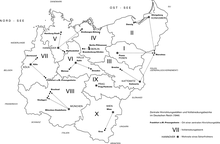Alois Weiss
Alois Weiß (born October 16, 1906 in Ruma , Croatia-Slavonia , Austria-Hungary , † February 26, 1969 in Straubing ) was a German executioner at the time of National Socialism in the German Empire . From 1943 to 1945 he was an executioner in the “ central execution site for Execution District IX ” in the Pankrác prison in Prague in the German-occupied Protectorate of Bohemia and Moravia . During this period, White was involved in a total of 1,079 executions .
Life
The former warehouse helper from Munich and assistant to the Munich executioner Johann Reichhart was the chief executioner in prison Pankrác (German: Pankratz ), a Gestapo remand prison in the south of Prague from February 2, 1943 . By 1945 1,079 people had been executed in the so-called Sekyrárna (hatchet room).
In 1943, Alois Weiß became the seventh chief executioner of the German Reich alongside Johann Reichhart , Ernst Reindel , Friedrich Hehr , Gottlob Bordt , Karl Henschke and August Köster , one of Hehr's assistants. On May 27, 1943, he beheaded ten people every minute within a quarter of an hour. Weiss' assistants were the Czechs Alfred Engel (from Holešovice ), Robert Týfa (born August 3, 1891 in České Budějovice ; † (executed) October 26, 1946 in Prague) and Jan Křížek, who changed his name to Johann Kreuz. The Gestapo later replaced the assistants, with new additions being Antonín Nerad (born October 19, 1889; † (executed) April 25, 1947 in Prague) from Prague-Braník and Otto Schweiger, Weiss's brother-in-law.
White was considered an efficient and reliable executioner. Including the protectorate allowance in the Protectorate of Bohemia and Moravia for German "followers" working there, his earnings during his period of activity were over 45,000 Reichsmarks .
After the war, Weiß lived in the Federal Republic of Germany . In 1947 the Bavarian judicial authorities wanted to reinstate the executioner of Prague in the Free State as an executioner. But the project came to nothing when the Basic Law abolished the death penalty in Germany in 1949 .
The former executioner became impoverished. In 1953 he sued the Regensburg Administrative Court for pension claims. He claimed that the abolition of the death penalty in Germany meant that he had lost his job but had not officially finished his job. White therefore demanded a fair wage. The court dismissed the application. In the end, the Weiß case was closed by the German and Czech authorities.
Alois Weiß died in Straubing at the age of 62.
See also
- Prague Special Court
- Marianne Golz
- Central execution sites
- List of people executed in the German Reich
- List of German executioners during the National Socialist era
literature
- Matthias Blazek: Executioner in Prussia and in the German Empire 1866–1945. ibidem-Verlag, Stuttgart 2010, ISBN 978-3-8382-0107-8 .
- Klaus Hillenbrand: Desired career as an executioner: Why men wanted to be executioners under National Socialism. Campus Verlag, Frankfurt / New York 2013, ISBN 978-3593-39723-8 .
- Marek Mahdal: Pankrácká sekyrárna. November 30, 2004 (includes the testimony of the Prague executioner [Appendix from 1945–1946] and information from the archive of the prison administration of the Czech Republic). ( Online resource .)
- Aleš Kýr: The Pankrác Memorial in Prague. Origin and development of the memorial and its historical exhibition until 1989. In: Perspektiven für die Dokumentationsstelle Brandenburg. ed. by Günter Morsch and Sylvia de Pasquale, LIT VERLAG, Münster 2004, pp. 87–88.
Web links
- Marianne Golz-Goldlust (January 31, 1895 - October 8, 1943), at rgolz.de
- "The execution went without any special features." Executions in Vienna, 1938 to 1945. Edited by Brigitte Bailer, Wolfgang Maderthaner and Kurt Scholz, Mandelbaum Verlag, Vienna 2013 , at doew.at
Individual evidence
- ↑ See Tankred Koch: History of the executioners - executioner fates from eight centuries. Heidelberg 1988/1991, p. 302.
- ↑ Cf. Richard J. Evans : Rituals of Retaliation - The Death Penalty in German History 1532–1987. Kindler, Hamburg 2001, ISBN 3-463-40400-1 , p. 864.
- ↑ Robert Týfa was Alois Weiss's assistant. He was executed on October 26, 1946 next to Cyril Hanzl (born July 1, 1893), Alois Hrůza (born July 14, 1893) and Walter Stögbauer (born May 8, 1898) in Prague. ( Seznam popravených pro retribuční trestné činy seřazených dle data popravy .)
- ↑ Antonín Nerad was Alois Weiß's assistant from March 1944. He was arrested in August 1945 and executed, along with others, in Prague prison on April 25, 1947. ( List of the people executed in Prague in 1947 , Hillenbrand, p. 150.)
- ↑ Hillenbrand, p. 108. Compare Stanislav Motl: Svědek z cely smrti. Rybka Publishers, Prague 2010, ISBN 978-80-87067-47-5 .
- ↑ The system of many guillotines. taz.de from September 4, 2010.
- ↑ executioner z. Wv. , DIE ZEIT, May 21, 1953, No. 21.
- ^ Stanislav Motl (ed.): Český rozhlas. Stopy, fakta, tajemství: Jedenáct smrtihlavů. rozhlas.cz (Czech), November 23, 2013.
- ↑ Information from the Straubing City Archives on the “Mittlere Meldekartei”, Alois Weiß. The information circulating on the Internet that Alois Weiß died in 1986 is for this reason that the specialist book author Klaus Hillenbrand describes it as incorrect.
| personal data | |
|---|---|
| SURNAME | White, Alois |
| BRIEF DESCRIPTION | German executioner |
| DATE OF BIRTH | October 16, 1906 |
| PLACE OF BIRTH | Ruma |
| DATE OF DEATH | 26th February 1969 |
| Place of death | Straubing |
